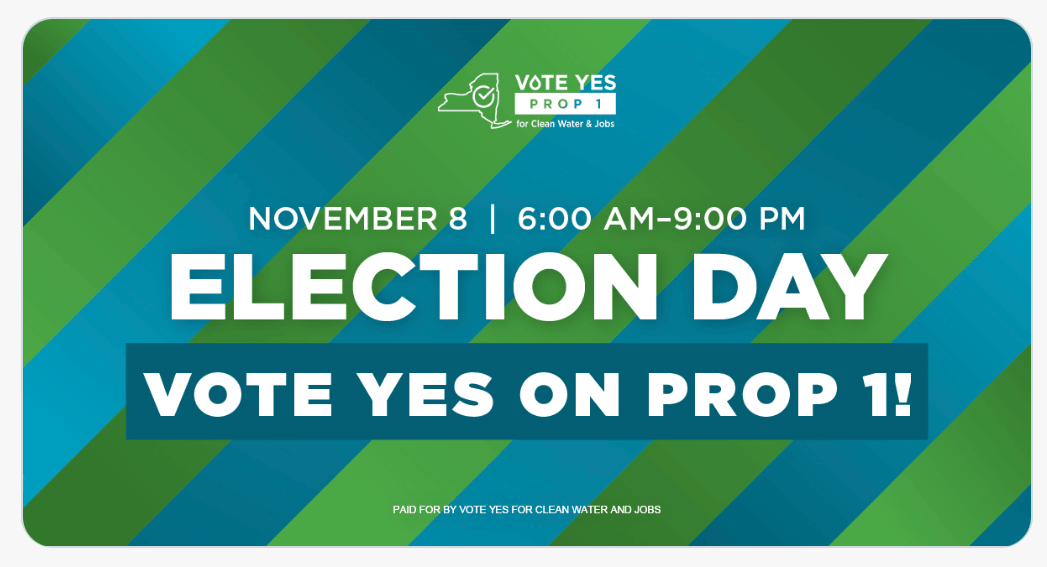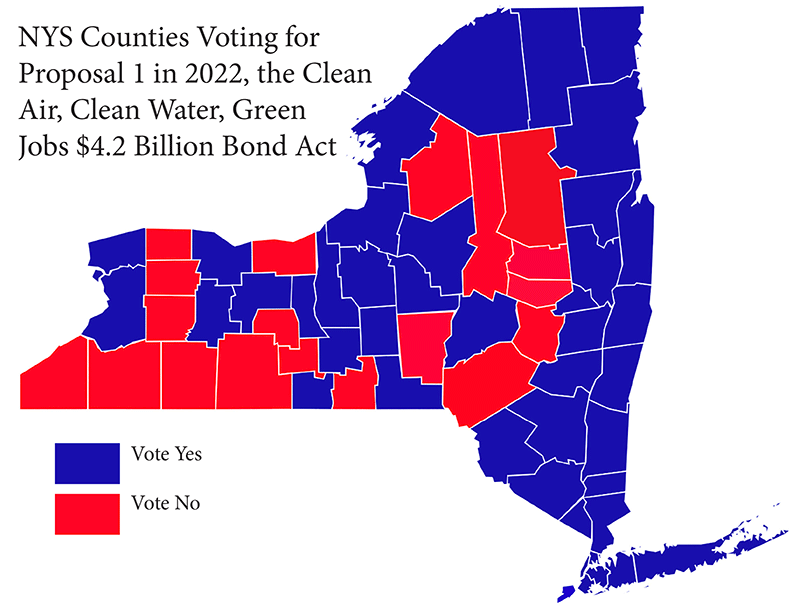The most popular thing on the ballot on Election Day in New York State was helping to protect the environment and fighting climate change. Turns out that protecting the environment and fighting against climate change is good politics.
The Clean Air, Clean Water, and Green Jobs $4.2 Billion Bond Act won big on November 8th across New York. The Bond Act racked up nearly 68% of the vote, as Bond Act supporters who voted “yes” more than doubled opponents who voted “no.” With votes still being tabulated in New York from absentees and early votes, the Bond Act stands at 3,348,188 to 1,580,379 with over 4.9 million New Yorkers voting on it.
Click here for county by county results.
The map above shows where various counties approved or opposed the Bond Act. The Bond Act won Long Island, all of New York City, the Hudson Valley, upstate cities of Albany Utica, Binghamton, Syracuse, Rochester and Buffalo. The Bond Act won the Adirondacks with only thinly populated counties in the central Adirondacks opposed. The Southern Tier voted no.
The Bond Act will be activated over the next decade. Here is a breakdown of the $4.2 billion Clean Air, Clean Water, and Green Jobs Bond Act environmental spending.
Bond Act will spend $1.5 billion on Climate Change Mitigation
At least $500 MILLION for zero emission school buses and supporting infrastructure.
At least $400 MILLION for green buildings, energy efficiency or renewable energy on state-owned properties, SUNY/CUNY, community colleges and public schools.
At least $200 MILLION for air and water pollution elimination in environmental justice communities.
At least $100 MILLION for climate adaptation and mitigation projects.
Other eligible projects:
- Urban heat reduction through green roofs, open space, community gardens, cool pavement, community cooling centers, and reflective roofs;
- Urban forestry projects such as forest and habitat restoration, planting of street trees;
- Protect natural and working lands that store or reduce carbon or methane pollution from agricultural lands.
Bond Act will spend $650 Million on Water Quality Improvement and Resilient Infrastructure
At least $200 MILLION for wastewater infrastructure upgrades and repairs.
At least $250 MILLION for municipal stormwater projects.
Other eligible projects:
- Reduce soil loss and runoff from farms, improve soil health, and restore buffers between farms and streams;
- Reduce harmful algal blooms and water pollution;
- Extend or establish sewer lines to replace polluting septic systems;
- Reduce water pollution by eliminating point or nonpoint source discharges;
- Reduce lead exposure by replacing lead service lines.
Bond Act will spend $650 million on Open Space Conservation and Recreation
At least $300 MILLION for open space land conservation.
At least $150 MILLION for farmland preservation At least $75 MILLION for fish hatchery creation and upgrades.
Other eligible projects:
- Land and farmland conservation projects with willing landowners/sellers;
- Fee or easement purchases by the state, a municipality, or a not-for-profit organization;
- Planning, design, construction of projects to develop and improve parks, campgrounds, nature centers, fish hatcheries, and other recreational facilities.
Bond Act will spend $1.1 billion on Restoration and Flood Risk Reduction
At least $100 MILLION for coastal rehabilitation and shoreline restoration.
At least $100 MILLION to reduce inland flooding and revitalize waterfronts.
$250 MILLION for flood buyouts and associated costs.
Other eligible projects:
- Restore natural areas and wildlife habitat including wetlands, streams, and forests;
- Protect people, roads, and buildings from flooding by acquiring, moving, lifting, or raising flood-prone properties, structures, and infrastructure;
- Relocate, repair, or raise flood-prone roadways; and update dams, bridges, and culverts.







